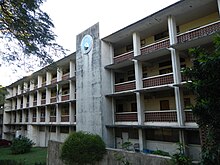Manila Observatory
 |
|
| Established | 1865 |
|---|---|
| Location | Quezon City, Philippines |
|
Operating agency
|
Ateneo de Manila University |
The Manila Observatory (originally the Observatorio Meteorológico del Ateneo Municipal de Manila, and later the Observatorio Meteorológico de Manila) is a non-profit research institute housed on the campus of the Ateneo de Manila University in Quezon City, Philippines.
Founded in 1865 by the Jesuits, it has served many purposes over the years including weather forecasting and earthquake research. Today it continues to carry out research in seismic and geomagnetic phenomena as well as radio and solar physics.
What led to the establishment of the observatory was an article published in Diario de Manila by Jesuit Fr. Jaime Nonell which described Jesuit Fr. Francisco Colina's observations of the typhoon of September 1865. The article led the public to ask Jesuit Superior Juan Vidal for the observations to be continued. After initial hesitation on the part of the Jesuits because of the primitive instruments available, the Superior yielded upon the promise of a Secchi Universal Meteorograph purchased from the Vatican.
Thus began the systemic observation of the Philippine weather. The institute was founded and led by Jesuit Friar Federico Faura. It started issuing warnings on typhoons in 1879, and the next year earthquake observations. In 1884 the Spanish government recognized the observatory as the official institution for weather forecasting in the Philippines. It started its time service in 1885, seismology in 1887, and astronomy in 1899.
The American, colonial government established it in 1901 as the Philippine Weather Bureau, which expanded into meteorology, astronomy, and geomagnetism. The work of the bureau was interrupted by the Second World War. During the Battle of Manila, all of the instruments and important documents of the bureau were destroyed and it ceased to function. A specific government agency was established in its place. The observatory resumed operation in 1951 in Baguio, mainly for studies on seismology and the ionosphere. In 1963 it was transferred to the Loyola Heights campus of the Ateneo de Manila University where it continues its studies into seismology, geomagnetism, and radio physics, among other areas of research.
...
Wikipedia
